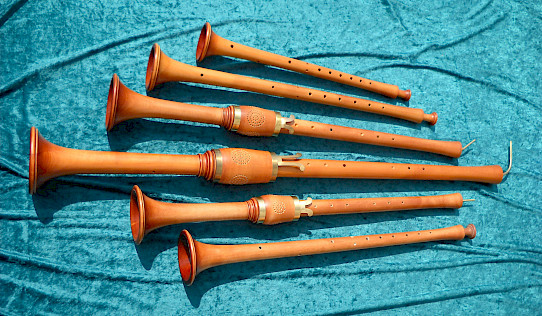Shawm
Woodwinds
Middle East
Between 1001 and 1900 AD
Video
The shawm is a historical double-reed woodwind instrument known for its loud and distinctive sound. It played a significant role in the music of the Medieval and Renaissance periods, often associated with folk and ceremonial music. The shawm is considered a precursor to the modern oboe and has influenced various musical traditions across Europe and beyond.
Description and Purpose
The shawm features a conical bore, typically made from wood such as boxwood or grenadilla. It has a long, straight body that terminates in a flared bell, similar to that of a trumpet, which enhances its projection. The instrument is played using a double reed, which is inserted into a socket at the top of the instrument. Shawms usually have seven finger holes on the front and one thumb hole at the back, allowing for a range of pitches.The primary purpose of the shawm is to provide melodic lines in various musical settings. It was widely used in outdoor performances, military bands, and ceremonial occasions due to its powerful sound. The shawm’s loud and penetrating tone made it ideal for leading ensembles during dances, celebrations, and public events. Additionally, it was often paired with percussion instruments to create lively musical arrangements.
History and Origin
The shawm’s origins can be traced back to the Middle East, where similar instruments have been played for centuries. It is believed to have been introduced into Europe during the Crusades in the 12th century, as European musicians encountered Middle Eastern instruments like the sorna and zurna. By the late 13th century, the shawm became established in European music, particularly in France and Italy.Throughout the Medieval and Renaissance periods, the shawm underwent significant development.
Its construction evolved to include various sizes and pitches, allowing for ensembles consisting entirely of shawms. By the 16th century, it had become standard equipment for town bands or waits, who were responsible for heralding municipal functions and signaling important times of day.
Working Mechanism
Playing a shawm, a traditional double-reed wind instrument, requires mastering breath control, embouchure, and finger techniques. To begin, assemble the instrument and ensure the reed is properly moistened, as it is essential for producing sound. Hold the shawm at an angle similar to a clarinet or oboe, resting the reed lightly between your lips while maintaining a firm yet relaxed embouchure. Blow steadily into the reed to create vibration, producing sound. Use your fingers to cover and uncover the tone holes to change pitches, ensuring airtight seals for accurate notes. Proper posture and diaphragm support are key to sustaining notes and controlling dynamics. With practice, you can produce the shawm’s characteristic robust, piercing tone, suitable for both melodic and harmonic roles in various musical styles.s.
Types of Shawm
There are several types of shawms based on size and pitch:
Soprano Shawm: The highest-pitched variant, commonly used in ensemble settings.
Alto Shawm: A mid-range version that offers a balance between treble and bass tones.
Tenor Shawm: Produces deeper tones suitable for various musical contexts.
Bass Shawm: The largest type, capable of producing very low pitches.
Each type serves specific roles within musical compositions, allowing for intricate harmonies and melodies.
Features
The shawm is distinguished by several key features:
The shawm is a historical woodwind instrument known for its powerful, penetrating sound and distinct construction. It features a conical wooden body with a flared bell, giving it a resonant, bright tone that can carry over large spaces, making it ideal for outdoor performances and ceremonial music. The double-reed mouthpiece, typically made from cane, produces sound through the vibration of its reeds, similar to modern oboes or bassoons.
The instrument usually has seven or more finger holes and sometimes additional keys to expand its range. Variants of the shawm come in different sizes, from soprano to bass, each contributing unique tonal qualities. Its robust and dynamic voice played a prominent role in medieval and Renaissance ensembles, paving the way for modern woodwinds.
The shawm is a vital instrument within early music traditions with deep historical roots and significant cultural importance. Its unique sound and versatility ensure its continued relevance in both traditional performances and modern interpretations of historical music.
FAQ
What is the Shawm and its Historical Context?
The Shawm is a double-reed woodwind instrument that originated in the Middle East and became prominent in Europe during the Medieval and Renaissance periods. It is considered a precursor to the modern oboe and was widely used in military and ceremonial music. The Shawm's loud and penetrating sound made it ideal for outdoor performances, and it was commonly employed in dance bands and civic ceremonies.
How is the Shawm Constructed?
The Shawm typically features a conical bore made from wood, with a wide bell at the end. It has several finger holes for pitch control and utilizes a double reed that is placed on a wooden disc called a pirouette. This design allows the player to produce a powerful sound, making it suitable for various musical contexts, especially in outdoor settings.
What Role Does the Shawm Play in Modern Music?
In modern music, the Shawm is primarily used in historical performance ensembles that focus on early music. While it has largely been replaced by more refined instruments like the oboe in contemporary orchestras, it remains popular in folk music traditions and is often featured in festivals and cultural events, where its distinctive sound adds to the festive atmosphere.
 Links
Links
References
Other Instrument
Categories


















